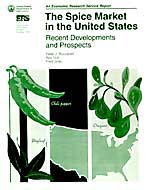The Spice Market in the United States: Recent Developments and Prospects
- by Peter J. Buzzanell, Rex Dull and Fred Gray
- 7/3/1995
Overview
On both a volume and value basis, the United States is the world's largest spice importer and consumer, with both imports and consumption on an uptrend for the past 10 years. While the United States imports more than 40 separate spices, seven of these (vanilla beans, black and white pepper, capsicums, sesame seed, cinnamon, mustard, and oregano) account for more than 75 percent of the total annual value of spice imports. While the United States imports spices from more than 50 countries, 5 of these countries (Indonesia, Mexico, India, Canada, and China) regularly account for one-half of the annual value of spice imports. The United States produces nearly 40 percent of its annual spice needs, with imports supplying the remainder. Growing domestic production consists of capsicum peppers, mustard seed, dehydrated onion and garlic, and herbs. U.S. spice exports have also been expanding in recent years, led by dehydrated garlic and onion. Rising domestic use of spices reflects growing Hispanic and Asian populations, a trend toward the use of spices to compensate for less salt and lower fat levels in foods, and heightened popularity of ethnic foods from Asia and Latin America.
Download
-
Entire report
Download PDF -
Introduction, U.S. Spice Supply
Download PDF -
U.S. Spice Utilization
Download PDF -
U.S. Spice Market Structure
Download PDF -
Role of the American Spice Trade Association
Download PDF -
Role of the U.S. Government
Download PDF -
Outlook
Download PDF -
Appendix Tables
Download PDF

